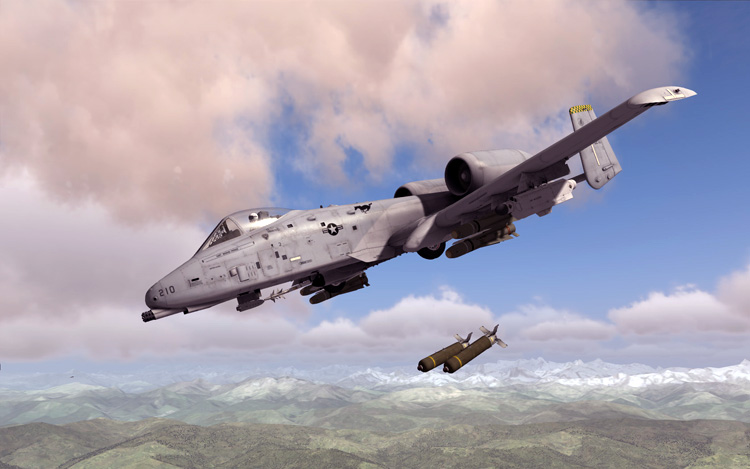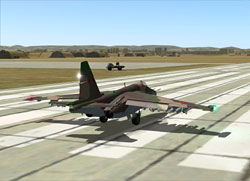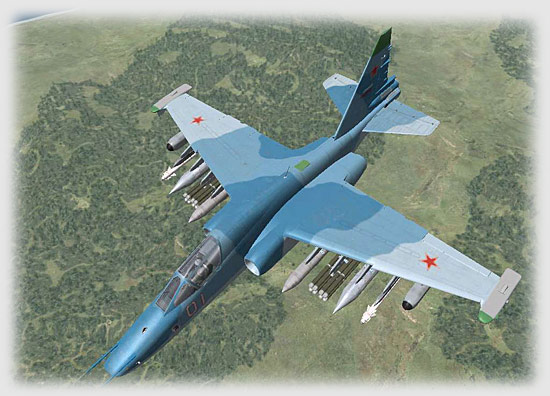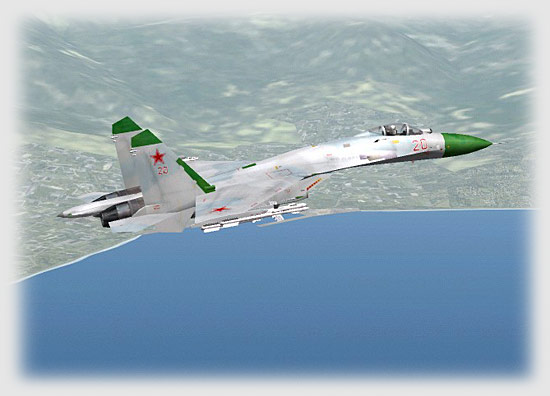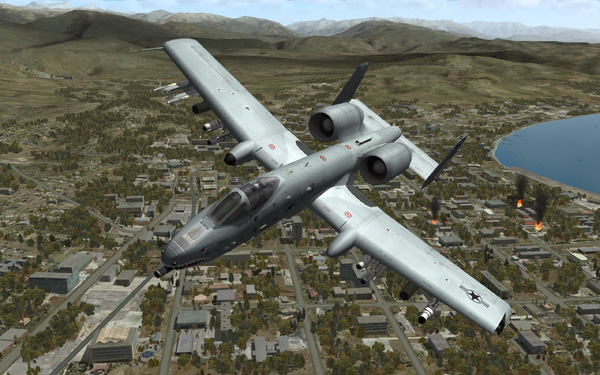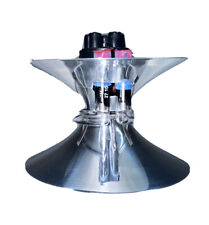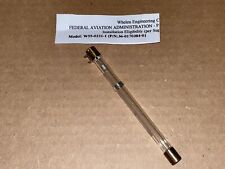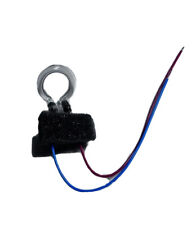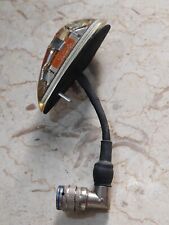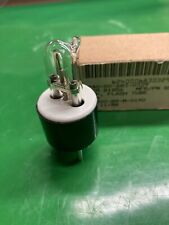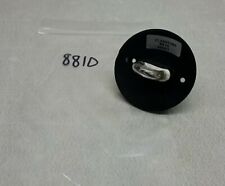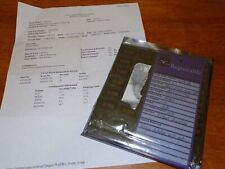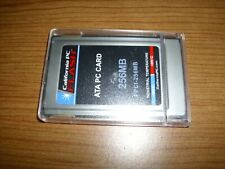Installation
I have not flown Flaming Cliffs in over three years and have not had it installed in two years. The first thing you will discover is that you must have Lock On v1.0 or higher before you can install FC2. The original Flaming Cliffs add-on is not required. I had to hunt down myLock On v1.0 disc and install from scratch. Base Lock On installed without a hitch in the Program Files (x86) directory of my Windows 7. Once that was done, the update installed without a hitch.
To obtain FC2, I navigated to http://lockon.co.uk, registered on the site, and downloaded it from there. I was pleased to learn that the company still had the record in its server of when I bought Flaming Cliffs v1 several years ago. What you download are three files — a setup file and then two archive files. The larger of the two setup files took me about an hour to download with Verizon FIOS broadband, so plan to be downloading for a while. You will be sent a copy of your serial number by email. Keep it, because you will need it later.
If you prefer a DVD version of Flaming Cliffs 2.0, you’ll be able to buy it May 2010 from here.
Many may initially be annoyed to learn that FC2 has DRM from Protection Technology, the same company that brought about the now infamous StarForce copy protection. Fortunately, Flaming Cliffs 2.0 uses the same version of DRM that is found on DCS: Black Sharkcalled FrontLine ProActive, and I have encountered no problems with it. Unlike the earlier StarForce, FrontLine ProActive does not install drivers, nor do you need to be online like in Ubisoft’s UPlay titles. You get eight activations and 10 deactivations (which saves an activation) of FC2. You only need to reactivate if you have made significant hardware changes. The number of times you can reinstall is unlimited. If you use these up, DCS will provide more — assuming your registration information is viable. Eagle Dynamics has also stated that they would remove the copy protection entirely if the company were to stop making games someday.
Menus and User Interface
Once FC2 installs, you will be faced with two new desktop icons. One a single player icon and the other a multiplayer icon. I have not explored the multiplayer side and will leave that discussion to “PFunk”. When you start FC2 for the first time, you will be confronted with the registration panel requiring you to enter your product serial number and telling you now many activations you have. Once you comply, the sim boots into the same start-up screen you see in DCS: Black Shark, with the same roundel of buttons in the same places. There is new themed background music. There is no disk check or re-entering of the serial code needed again.
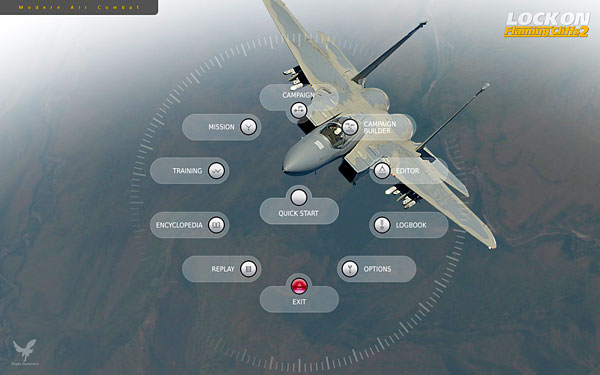 |
Menu navigation is identical to DCS: Black Shark. The game recognized my antiquated Thrustmaster Top Gun Fox 2 Pro, and apparently does so by interfacing with Windows 7. After I calibrated the stick in Win 7, I encountered no problems. In the Options menu, you will see that you can set up a HOTAS for each different aircraft presented. I was disappointed to see that the Ka-50 was not present in the options; I have DCS:BS installed and hoped that the two would work together offline, but I found out it’s not going to happen. Lock On is owned by Ubisoft and DCS is owned by The Fighter Collection and Eagle Dynamics. The two cannot be combined as a single install.
The supporting documentation advises that they do interface in multiplay, which is an exciting development.
I found the need to program each aircraft to my stick cumbersome. SimHQ asked Matt what the reason was for the multiple controller programming. He explained the thoughts behind it, “Most of the aircraft have unique controls that force users to create unique profiles according to the aircraft they want to fly. This new system automatically loads the created input profile when the aircraft is selected to fly. While a little more work upfront, it provides much greater freedom when to create unique profiles for each aircraft and it takes advantage of their unique controls. This is particularly true regarding the control differences between the U.S. and Russian aircraft.”
Also, the sim I have the most recent stick time in is IL-2 Sturmovik 1946, and I have become accustomed to the snap-view and the padlock system present therein. Lock On’s system is very different and what they call a snap view in the options isn’t the same thing; rather, their snap views are incremental and do not snap back to center. There is a “glance” view option that is similar to IL-2’s snap views but they do not have the range of motion that IL-2 has.
Training is handled by in-game flights with narration and text overlays. While there are 36 training videos available, the biggest problem with FC2’s training is less depth than the training found in DCS: Black Shark. I suppose the fact that eight planes would have needed to be done to the depth of DCS: Black Shark explains why this survey sim didn’t receive the same training detail.
 |
In game, I got a strong feeling the developers are betting most users will have a NaturalPoint TrackIR system. When I met with Matt Wagner in December at I/ITSEC and got a look at the military version of A-10C, it was connected to a TrackIR system. I don’t use TrackIR; I find it disconcerting. Those of you who do will find it supported well in FC2, and the limited 6 degrees-of-freedom cockpits will complement it well.
Flaming Cliffs 2 has the same comprehensive mission editor that DCS: Black Shark has, and the sim is set in the same world. The editor has tooltips, and if you have any familiarity with the Lock On series you will be able to pick-it-up without a manual. If you need a manual, there are three of them that ship with the sim, all in pdf format. These include a quick-start, a flight manual, and GUI (menu interface) manual. TFC plans to release a hard copy of the flight manual soon. But the mechanics of the game are unchanged from Lock On and the original Flaming Cliffs, and once I noodled around a bit in a test mission I made, I began to pick up the basics again without trouble. Look for more on the Flaming Cliffs 2.0 mission editor soon from SimHQ.
 |
Gameplay
FC2 has four phased campaigns and 91 stand-alone single missions. There is no dynamic campaign, and no plan (I know of) to add one to the Lock On series. DCS could be a different matter! When I discussed this with Matt Wagner in December, his take on the dynamic campaign was that their work with the military demanded, a powerful mission editor and scripting capabilities to create more realistic scenarios than dynamic campaigns are capable of generating. However, it is certainly something they wish to do at a later date.
One of the biggest criticisms of the Flanker series and its descendants has been the relative sterility of the world in which you fly. The development team has tried to address this criticism in detail. You can get a good feel for the campaigns by looking at Chris “BeachAV8R” Frishmuth’s FC2 After Action Reports which are both entertaining and educational.
The environment, such as clouds, ground textures, trees, terrain elevation mesh detail, ground units, airfield textures, have been very much upgraded. The map has been expanded into Georgia.
The sim has a new sound engine, and I really like some of the new engine sounds particularly. And radio comms are upgraded and sound a little less mechanical. If you have stick time in DCS: Black Shark, the changes will be familiar to you. Included campaigns and missions feature the U.S. aircraft, the MiG-29, the original Su-25 and Su-25T, and the Su-27 and 33, though the campaign game is limited to the two U.S. aircraft and the Su-25 on the Russian side.
The phased campaigns and single missions show a lot of detail, because of the mission editor’s flexibility. If you’ve seen the screenshots Thomas Weiss has taken for recent episodes of the “Sacha Chronicles”, you can see just what the mission editor is capable of in skilled hands. FC2 is no different here. Their are real changes under the hood (like the triggers) and have to be experienced.
Flaming Cliffs 2.0 boasts the following (list extracted from an FC2 press announcement):
- Improved Mission Editor with trigger system
- Terrain area to include much of Georgia (this is the same map as used in DCS: Black Shark. As such the Crimea has been replaced with the addition of Georgia)
- More detailed terrain that includes additional ground objects, larger forests, and higher resolution elevation data
- Improved clouds
- High resolution airfield textures
- An improved multiplayer system with embedded game browser
- More robust online cheating prevention
- New and improved menu system
- Numerous new, highly detailed ground units including infantry
- More accurate flight data that controls flight performance of player-controlled aircraft. This is true for both Russian and U.S. aircraft
- Improved flight models for all artificial intelligence (AI) controlled aircraft
- New, more realistic G-tolerance modeling
- Limited 6-DOF cockpits that move up, down and sideways according to maneuvering
- Heads Up Display (HUD) now modeled as collimated and focused to infinity for all player-controlled aircraft
- New and highly-detailed Su-25 model
- Advanced ballistics are implemented for all flyable aircraft, including ricochets of AP rounds
- F-15C locked target IFF indication
- More realistic ranges, seeker guidance and fuses for air-to-air missiles
- More realistic electronic countermeasure operation and performance
- New and improved sound engine
- New radio message voiceovers
I have flown the MiG-29A, Su-27, and Su-25 in-game, and I can attest that the changes are for the most part beautiful. In the Su-27, however, a long-time graphical glitch of the MFD still exists where the green grid in modes with the radar off bleeds noticeably into the surrounding artwork, and that always has been an immersion-killer for me in the Su-27.
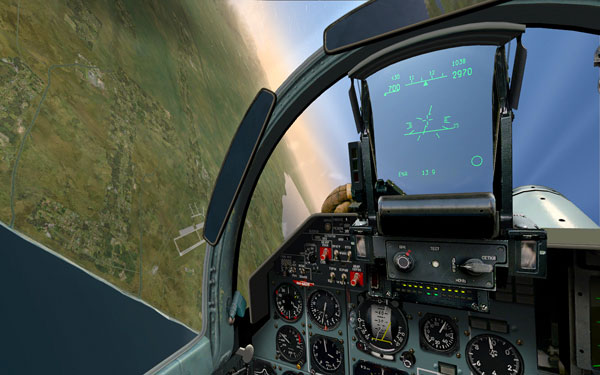 |
That is not present in the MiG-29, and I have had a lot of fun putting it through its paces. All the improved Russian radar modes from the v1.12 version of FC are present, and all work as expected. This is still one of the most detailed air-to-air radars out there, and it faithfully models the first version of the N-019 radars in the original MiG-29 9-12. The new HUD looks great in the MiG-29 as well.
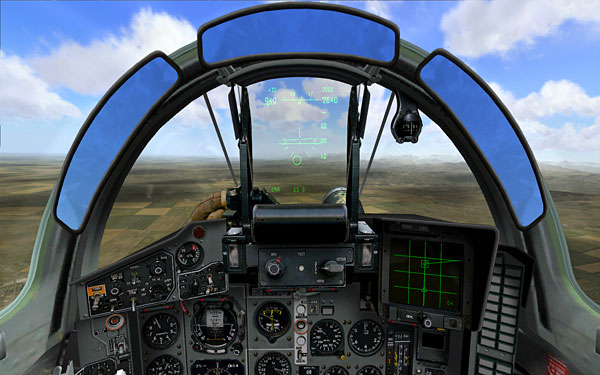 |
 |
Among the Russian aircraft, though, it is the original Su-25 that has seen the most improvement. In FC v1.12 the dev team introduced the Advanced Flight Model, which has been tweaked further in FC2. The new model is richly detailed, and in my opinion is worth the investment in itself if you’re into Russian air-to-ground operations. Russia’s little Rook is their national aircraft; it carries on the tradition of the IL-2 Sturmovik of World War II, and in the Red Air Force it carries the same prestige as the F-15 and F-16 do in America. Stripped of weapons, it is capable of near-supersonic speed in level flight, and is handy and maneuverable. FC2 replicates these features in fine detail, and as you load on munitions the Su-25 begins to take on flight characteristics reminiscent of the A-10C in the DCS military simulator I flew last December. It is touchy on takeoff, and although I have not come close to crashing, I can see that a heavy hand will cause you to ground-loop as you head down the runway. When I flew the A-10C, I crashed the first time out because of a TrackIR mis-calibration glitch. The Su-25 has the same feel of walking a tightrope until you get enough speed and then aerodynamics take over. You bleed energy fast in tight turns, and if you pull out of a dive too late you’ll crash into the ground.
Air-to-ground weapons modeling has received attention. You can program ripple releases and salvo releases of bombs, and other weapons. The Su-25 embarks Klen-PS, the onboard laser illuminator and rangefinder, and as in the original FC you can target laser missiles and bombs with deadly accuracy.
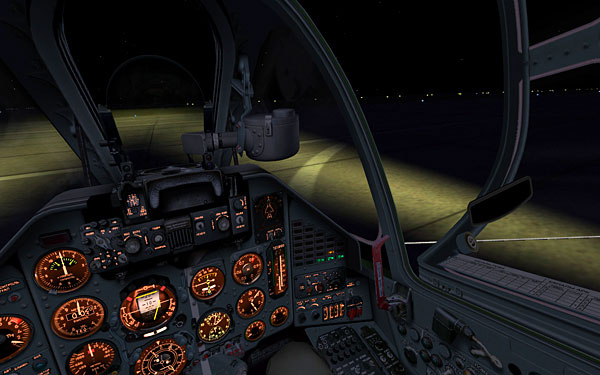 |
 |
The Su-25T, the more advanced Su-25 variant, still has Fantasmagoriya, the Russian equivalent to HTS, for your use of KH-25MP anti-radar missiles, and the ability to embark precision-guided munitions to be guided by the I-251 Shkval day television, and can carry the Mercury low-light-level television system for night operations.
Electronic countermeasures have had some love too with ranges and effectiveness of jamming equipment tweaked. The Su-25 can load the venerable Gvozdika, the SPS-141 radar jammer, and I highly recommend it because it’ll increase your survivability. Su-25T aircraft get the more modern MPS-410 wingtip-mounted system, and carry an IR-strobe jammer for protection against MANPADs from the ground. The Su-25T is an ideal platform for anti-insurgent operations.
If I were to fly one aircraft to the exclusion of all others in game, it would be the MiG-29S, which is designed on the model 9-13. In real life, the 9-13’s N-019 radar is advanced, and has multi-target engagement capacity. In game, the 9-13 is not so effective, and is modeled along the lines of an export-variant 9-13 with the earlier N-001 radar of the 9-12. The MiG-29 9-12 isn’t survivable on the modern battlefield unless the pilot is very skilled. The 9-13, however, still carries the internal Gardeniya radar-jammer. For Sukhoi fast-movers, you’ll want to embark the SPS-171 Sorbtsiya jammer system in hostile environments. Both systems work similarly and both have been tweaked in Flaming Cliffs 2.0.
As I noted previously, the Russian N-001 and N-019 radars are the FC v1.12 improved versions, with track-while-fly mode available. Unlike later Zhuk radars, the earlier version requires you to transition to single-target track to launch radar guided missiles. The system will still do so automatically once you designate a T-W-F target, as in prior versions of FC. The difference you will see is in how the N-019 radar interfaces with R-27/AA-10 missiles. Guidance and fusing have been tweaked and the “Alamo” is much more effective as a result. Russian doctrine encourages pilots to salvo IR and radar missiles. I have found that with the systems improvements, I can use the onboard electro-optical system (EOS or IRST) to an advantage. The 9-13 can carry extended-range R-27TE and RE missiles, with a 60km maximum range. Once the EOS locks the inbound target, you can launch the R-27T/TE. This will invariably cause the enemy aircraft to go defensive, because its missile warning system will detect the launch. I then activate the radar, go into DVB mode, lock target, and launch the R-27R/RE. With the T inbound, the maneuvering target may put its tailpipes toward the inbound missile, increasing a chance to hit. And with him using up his energy defeating the IR missile, you have a chance of scoring before he can launch an AIM-120. Keep in mind that AIM-120 is semi-active radar guided for the first part of its flight, so if the enemy gets one off at you, if you’ve fired first you can still f-pole him down if you’re a good stick. With the redesigned HUD presentation, it’s a beautiful thing to see as it’s happening.
 |
Russian aircraft can still track a jamming aircraft as well. The radars, when they detect jamming, will go into AOJ (angle-on-jam) mode, and you can designate the jamming strobe and launch R-27 R/RE missiles. They home-on-jam, and if you burn through on the merge, will transition over to semi-active guidance.
All in all, from the Russian side FC2 is worth the price of admission. It gives players the ability to bring the Russian jets into multiplay to fly alongside the Ka-50 in DCS: Black Shark, and gives U.S. players a chance to play an opposing force against them.
At this point I’m going to turn it over to Chuck “PFunk” Bellows for the next section of the review.
– “Cat”


